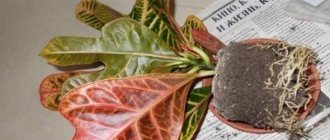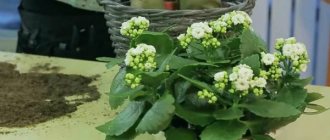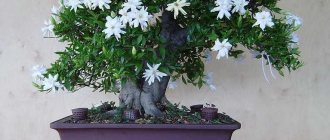Croton (or codiaum) is a houseplant distinguished by its unusual beauty.
The following types of Croton are very popular among gardeners: Motley, Petra, Excellent, Tamara.
At the same time, this is a very capricious flower that requires special care.
It should not be replanted more than once every 2-3 years.
Since replanting is difficult for , you need to know all the features of the process: when is the best time to carry it out, what kind of soil and pot is best to use, and much more.
Peculiarities
Croton is replanted once every 2-3 years ; in some cases, replanting is allowed after 4 years.
Croton should not be disturbed during the flowering period. Therefore, the optimal time for transplantation is March. It is at this time that the growing season begins.
Transplantation after purchase is very important for codiaum; it is best to do it as soon as possible.
The substrate in which the flower “lived” in the store and during transportation, at home, can lead to the leaves drying out and falling off, other Croton diseases, and even the death of the plant .
Croton is replanted for several reasons:
- becomes depleted over time and needs to be replaced;
- The root system develops and there is little room for it in the pot. Therefore, a sign that it is time to move a flower is the appearance of roots on the surface of the ground.
Each subsequent one should be 2-3 cm larger than the previous one . You should use plastic or clay ones.
Home care
To care for the codiaum, you should regularly allocate a sufficient amount of time for this. The plant is capricious, so you need to observe certain maintenance conditions, carefully control watering and fertilize the soil. In addition, you will need to replant the flower often, and this needs to be done correctly.
Soil requirements
Codiaum is not very picky about the soil. Universal soil can be purchased in a store, and the package must contain the mark “suitable for decorative deciduous houseplants.”
The pot must be stable; clay or plastic are equally suitable. The diameter of the container is half the crown. Each new transplant will require preparing a container 2 cm in diameter larger than the previous one.
Optimal conditions of detention
Croton is a sun-loving plant. When maintaining it, it will need to be provided with a sufficient amount of sunlight, but it is better not to leave it in direct rays. In summer, it is better to place the pot on the north side of the window, and in winter - on the south.
Codiaum grows very well in the fresh air, so whenever possible it can be taken out to the balcony. However, you need to ensure there are no drafts, as the color does not tolerate them. The optimal temperature for keeping in summer is about 20-23 degrees, in winter – from 16 and above.
Watering a flower
Watering the soil should also be carefully adjusted by the gardener. The flower does not tolerate overwatering, but it also does not like drought. In both cases, the leaves quickly react by yellowing and dying.
To avoid overwatering, the soil and pot must have good drainage. Excess moisture will drain into the pan. In summer, the earthen ball should be moistened abundantly, and in winter it is recommended to reduce watering. The soil should always be slightly moist. Watering must be done with warm water, which has previously been left at room temperature.
Be sure to wipe the sheets with a damp sponge at least 2 times a week. This will remove dust from the plant, allowing it to grow better and look neater.
Feeding and fertilizer
Fertilizing croton is also an important step in caring for it. For feeding, it is recommended to purchase a ready-made mineral composition that is suitable for this type of plant.
Feeding should be done at least 2 times a month. It is necessary to start fertilizing the soil in April and finish in November.
Carrying out pruning
In order for the plant to delight with a lush and beautiful crown, it must be periodically pruned. For young codiaums, pinching is used. Any buds or flowers that appear are also removed. This greatly exhausts the codiaum, causing it to lose all its beauty.
After cutting off unnecessary sheets, it is important to treat all cuts with charcoal powder
How to replant correctly?
To replant a flower, it is transshipped. It is recommended to replant young plants at least 2 times a year, as they are characterized by intensive growth. An adult croton will need to be replanted once every two years.
How to perform transshipment:
- Wear gloves.
- Gently holding the plant, remove it from the pot.
- Lightly shake off excess soil, then place in a new container.
- Fill the voids with fresh soil, not reaching a distance of 1 cm from the surface.
When the root system fits into a 25-centimeter diameter pot, replanting will no longer be necessary. It will be enough to remove the top layer of soil once a year and place fresh soil in its place.
Winter care
In the winter season, almost all care procedures for croton are preserved, but are reduced in quantity. In winter, codiaum does well without fertilizer, but if the grower leaves feeding, it must be reduced to once a month.
You need to water the plant less often, but you also need to make sure that the soil does not dry out and is slightly moist.
It is recommended to avoid showering until spring, but it is important to continue washing the leaves. It is also better to reduce the number of wipes
Transplant instructions
The soil must first be prepared. Its composition depends on age.
For young plants, the soil for replanting consists of coarse river sand, leaf soil and turf soil, mixed in a ratio of 1:2:1. For an adult, the ratio is 1:3:1, respectively.
You can also use soil purchased at the store. It is recommended to add a little leaf soil to it Before planting, the soil should be shed with a weak solution of potassium permanganate and dried.
Drainage
must be placed at the bottom - expanded clay or clay shards. It should fill ¼ of the pot.
After preparing the pot and soil, you can begin replanting the croton:
Drainage is laid at the bottom , soil is poured on top. The earth is moistened and a depression is made in the center.
The croton is removed from the old one. You need to pull it out carefully . You cannot disassemble its roots and remove soil from them. The plant is transplanted together with a lump of earth.
The exception is a flower that is replanted after being purchased in a store. You need to shake off as much substrate as possible from the roots of such a croton. However, disassembling the roots is also not recommended;
An earthen ball with roots is placed in a recess in the new one and covered with the remains of the new soil. There should be no voids in the pot , so the earth is slightly pressed down;
The transplanted croton is watered. After transplantation high humidity , so it needs to be watered daily . also recommended to spray it with a spray bottle.
Changing the adult and seating the children
After purchasing croton from a store, it is important to replant it as quickly as possible. An adult plant is replanted once every 2-3 years. A young plant requires changing the soil every year. Cuttings with roots up to 5 cm in length require rooting in nutritious soil.
Substrate
The soil for croton needs to be loose and light, since the plant does not like moisture, but will not tolerate stagnation of water in the soil. The soil must be nutritious. A good combination can be obtained by mixing in equal parts:
- humus;
- turf land;
- leaf soil;
- sand
- peat.
A universal substrate will also work, to which you will need to add a third of sand. Before use, the soil must be treated with potassium permanganate and dried.
Important! For healthy flower development during transplantation, you need to change the drainage layer, making a new one at least 2 cm.
Pot
Croton is one of those plants that, in a large pot, are busy growing roots until they cover its entire area. Therefore, the pot should be small, no matter how strange it may look in comparison with the size of the bush growing from it.
The size of the pot should freely accommodate all the roots of the flower + 1 cm of free space around for soil.
Clay and plastic pots are suitable for codiaum. It is important to have a drainage hole; stagnation of water is the cause of death.
It is important to know! It is better to transplant an adult flower in March using the transshipment method.
After transplanting, it is necessary to place the pot in a warm place, maintain humidity and watering.
Croton is difficult to tolerate transplantation, so during this period you need to provide it with as comfortable conditions as possible.
To the question of how to transplant a diseased croton, the answer is quite obvious. Experienced flower lovers advise curing it and then replanting it.
Seedlings (dividing the bush)
Sometimes the plant becomes too crowded in the pot. In this case, it is necessary to propagate the croton (plant).
The process is also recommended to coincide with the beginning of spring.
Pots with drainage and substrate (soil for young and adults) are pre-prepared. The day before transplanting, the plant is watered abundantly.
Seating is carried out as follows. The codiemu bush is removed and divided into several parts : the main plant and root children . A large bush is planted in a large pot with soil for an adult plant.
Small shoots are placed in small pots with soil for young flowers, covered with plastic wrap and placed in a warm place.
Briefly about croton
Another name for Codiaum is a perennial plant that belongs to the Euphorbiaceae family. Quite beautiful, but requires attention and knowledge of care features.
The name of the flower itself comes from the ancient Greek city and means “head”. There are several versions of the origin of this name, but many are inclined to believe that its authorship belongs to the botanist Georg Rumphis.
One of the most important questions that every gardener should ask himself when purchasing is: how to replant croton?
There are several methods, but one of the best is the transfer method - transferring the plant along with a lump of soil into a new container. First, a new drainage layer of charcoal and expanded clay must be placed in the pot.
Young plants need to be replanted every year, but flowers of older generations should be replanted no more often than once every few years. It is also important to take into account that when replanting, a complete replacement of the soil is not recommended, since the root of the codiaum is very thin and difficult to adapt to changing conditions.
The flower does not need too large containers; it is important that the root fits and does not bend at the bottom. When choosing a flowerpot, you should focus on both ceramics and plastic. However, there must be holes at the bottom of the container to allow excess water to escape. Otherwise, the root may begin to rot.
This is a delicate plant that requires special attention. However, if you take into account all the nuances and look after it properly, the flower will certainly please the owner.
Landing
In order to properly plant croton, you first need to cut a cutting on which several internodes will be located. After this, it is very important to rinse the cut with a small amount of water. In this way, it is possible to destroy the film, which can prevent the rooting process of the cuttings.
- The cut cuttings will have to be planted in the soil, which should consist of sand and earth. In this case, it is important to compact the soil a little near the planted cuttings.
- It is very important to water the planted croton. To do this, water the young plant once every 5 days. In this case, settled water is used.
- A prerequisite for rooting cuttings is the construction of a mini-greenhouse. It is very easy to make from a plastic bag. After this, the plant is placed in the shade and fresh air is allowed inside every couple of days.
Location and lighting
Croton, unlike many other plants, loves bright sunlight very much. At the same time, its foliage does not lose its original color, but only becomes stronger.
It is recommended to place the flower pot on the windowsill, which is located on the south side. In hot weather, the flower will need to create a small shade. This will help avoid severe leaf burns.
The plant can also be placed on the east and west sides of the house in a special floor stand. The flower must be placed in such a way that natural light can illuminate the croton for as long as possible throughout the day.
With the onset of cold weather, fluorescent lamps and phyto-lamps can be used for lighting.
Pot sizes
The active growth of the plant will primarily depend on the condition of the root system of the flower. It is for this reason that the choice of a flower pot must be approached with great responsibility.
The best pot for croton can be a wide, but not too deep pot. This pot size will allow the roots of the plant to be positioned with maximum comfort for the flower. If you go too far with the size, then all the water that will be used for irrigation will go to the roots. Which in turn can cause root rot.
The pot should be as stable and practical as possible. Don't pay attention to clay pots. Their disadvantage is their heavy weight and the creation of some inconveniences for the growth of the flower. The best option in this situation would be a pot made of plastic.
The soil
When planting and replanting croton, the quality of the soil is very important. In order for the plant to grow comfortably at home, it is necessary to select loose and well-drained soil. At the same time, it must be breathable and have an average level of acidity. For croton it has an approximate pH of 6.1 to 6.5.
Preparing the soil for planting a flower is quite simple. To do this you will need turf soil, sheet soil and sand. All ingredients are mixed in a ratio of 1:2:1. Before planting a plant in the ground, the soil must be disinfected. To do this, you can pour a small amount of potassium permanganate solution on it. This will make it possible to avoid the appearance of flower parasites.
Croton can also grow well in hydroponics.
Transfer
In order for the plant to develop normally and sometimes produce flower stalks, it must be replanted.
Is it necessary to replant Croton after purchase?
Most of the flowers that arrive on store shelves either arrived from abroad in a specialized substrate for transportation, or were grown in industrial conditions.
In both cases, the substrate on which the flower grows at the time of purchase is not suitable for long-term cultivation, because:
- It is not suitable for irrigation and under the influence of water it only gets wet, not allowing the necessary oxygen to pass through;
- Stopping air access leads to the formation of rot on the roots;
- On it, during transportation, the plant suffered too much stress, which can negatively affect the condition of the codiaum.
How often should croton be replanted during cultivation?
Depending on the age of the flower, the need for replanting varies:
- It is recommended to replant mature ones no more than once every three years, as the root system grows. In this case, it is worth considering that the diameter of the new pot should be three to five centimeters larger than the old one. Don't buy too large a container;
- Young ones need annual transplantation in the spring, or in extreme cases, summer, period.
Before transplanting into a new container, it is recommended to add new fertile soil.
If you are not sure that you know exactly how and when to replant codiaum, you should not experiment. There is a high risk of damaging the plant.
In addition, during the growing process you can change the shape of the flower. By pinching off the top shoot, giving it the shape of a bush. However, it is worth considering that in this case, the formation of the crown will occur more slowly, since the lateral branches grow more slowly than the axial stem.
Before you start transplanting, it is recommended to familiarize yourself with its features. Colodium is a capricious flower that needs close care and neglect can lead to its death.
Description of the flower
Croton is sometimes called codiaum or "Joseph's cloak." Translated from Greek, the name of the plant means “head”. Why the culture received such a name, experts do not know for sure. There is an assumption that the plant was named after a city in southern Italy.
The islands of Northern Australia and the Pacific Ocean, as well as Southeast Asia and India are considered the homeland of wild forms of croton. The genus has many species. But indoor culture is represented only by variegated croton and its hybrids. The croton flower (photos are given in the article) is considered one of the most beautiful decorative indoor crops. The plant is used as interior decoration. In some countries, croton is considered the guardian of the hearth, which protects the apartment from negative energy.
At home, the plant usually does not exceed 1-1.5 m in height, even with the best care. The description of a croton flower, of course, cannot convey all its beauty. The decorative nature of the plant is its main advantage. Crotons are often used to decorate halls, lobbies, offices and other premises.
Their beautiful leaves of various shapes and bright colors invariably attract people's attention. Externally, codiaums resemble a small tree
The formation of the crown occurs quite slowly, so you should not hope for a quick result. In order to get a beautiful bush, the plant is periodically pruned.
Codiaum is a flowering plant. But the culture rarely blooms. At the same time, the plant produces an arrow with small, inconspicuous flowers, painted in a light yellow tint. It is worth saying that flowering does not add any special beauty to croton. But the plant spends a lot of energy and nutrients. Therefore, many gardeners prefer to initially remove the arrow so that the crop does not lose its supply of nutrients.
What soil is needed, what fertilizers should be used
Crotons, including young ones, need fertile soil. In addition, it is important to enrich the soil with fertilizers during intensive flower growth. Almost any complex fertilizer intended for indoor deciduous plants is suitable for feeding.
It is recommended to fertilize the substrate after watering.
Since codiaum comes from the tropical zone, the substrate must correspond to the characteristics of this area.
Fortunately, preparing it is not so difficult; to do this, you need to add the following to the ground in equal proportions:
In addition, it is recommended to freeze the finished substrate before transplanting. This will prevent the development of harmful bacteria that cause diseases and destroy pest larvae.
When laying the soil, you need to place some fine charcoal in it. This is one of the best methods of protecting roots from rot.
With the correct composition of the substrate, codiaum will easily replant and will not cause any inconvenience to the owner.
Croton propagation by leaf
The most common method of propagation is buried shoots. To do this, use one of the branches of the mother colodiaum, which is sprinkled with soil. After some time, it should take root and the seedling is ready for transplanting.
For a plant such as codiaum, propagation by leaves or apical cuttings is not particularly common, but some gardeners also practice it.
To do this you need:
- Choose strong cuttings up to fifteen centimeters long;
- Place in a container with a mixture of water and charcoal;
- Wait until the secretion of milky juice in the cut areas completely stops;
- Remove the cuttings from the water and let them dry;
- Plant in prepared soil. Maintain greenhouse conditions until rooting.
The best time to propagate croton leaves is spring. After the cuttings take root, it is recommended to place them in a well-ventilated area and spray them every day.
After a month, the seedlings can be planted in separate containers.
Leaf propagation is one of the methods used. It is recommended to carry out such seating in the spring.
Which method to choose
Cuttings or leaves
Most often, croton propagation is carried out by cuttings. Not only apical shoots take root well, but also cuttings with one leaf or a dormant bud. Croton propagation by leaves without a bud will not occur.
The best time for pinching is the first months of spring, when the shoots are actively growing. You need to cut off a fragment that contains a bud and an adult leaf blade. You need to pinch the top within 6–10 cm, then the future croton will have a strong trunk and rhizomes. In order for a piece of the stem to take root in the future, it must be cut from a healthy shoot.
We offer step-by-step instructions for preparing planting material:
- Dry the cut areas with a napkin.
- Large leaf plates that take away nutrients from the cuttings are cut in half.
- If the lower leaves also interfere with rooting, remove them.
- We keep the cuttings in the air for a couple of hours.
- Place the planting material in a glass of water.
It is very important that the temperature of the liquid is 24–30 °C. If it cools down, the roots will develop slowly and the seedling may eventually die.
Planting material should be exposed to the diffused rays of the sun throughout the day.
When roots appear on the cuttings, you can transplant them into the ground. It is enough that the shoots are 2–3 cm long, then they will not be damaged during transplantation, and the plant will quickly grow. If you have chosen the correct composition of the soil mixture, then within a couple of weeks the croton will acclimatize and quickly take root.
Video “How to propagate croton by cuttings”
Video about how to propagate codiaum (croton) by cuttings at home.
Air layering
When the trunk or branches are left without leaves, croton propagation is carried out by air layering. This method is interesting, but very painstaking. The summer months are most suitable for this procedure. Let's consider two methods of such reproduction.
The pouch method involves cutting off the bark in a circle at a distance of 10–15 cm from the top of the shoot to create a ring 1 cm wide. This place will be the launching pad for new roots.
The cut site is treated with a special rooting agent and covered with peat. A film is placed on top like a bag, which is tied at the top and bottom so that a gap remains, through which the peat is moistened for 60 days until roots 5 cm long appear from it. After which the cutting can be cut and transplanted into a pot.
You can also propagate croton using the buried shoot method. To do this, the branch on which the bark has formed is pressed to the surface and sprinkled with earth. Then the bottom edge of the branch is cut. Any juice that comes out must be wiped off, as it is poisonous. The incision is treated with a special agent to root it. The shoot is separated from the mother branch after rooting and transplanted into a flowerpot.
Seeds
Like other plants, croton can reproduce by seeds. But this method is rarely used. If a gardener decides to undertake such an experiment, then he needs to know the following:
- this is a long process;
- plants that appear in this way rarely retain the characteristics of the variety.
They should be planted in February. First, the seeds are poured with warm water. After 15 hours, they are soaked for a couple of hours in a solution of phytohormones. Next, prepare the soil mixture and fill the containers with it. The prepared seeds are buried 1 cm into the soil and a small greenhouse is made, covered with a jar or film.
Seeds are germinated at a temperature of +24 °C. Watering the seedlings is carried out through a tray. After 30 days, the first shoots will hatch. They require attention because they are weak and develop very slowly. When a couple of leaves appear on them, they can be picked. Care for seedlings is the same as for adult plants.
At the final stage, the seedlings are planted in separate flowerpots.
We told you how to propagate homemade croton. Some methods were simple, others could only be done by experienced gardeners. Which method to choose is up to you.
Features of care, pruning croton
For the croton plant, pruning or pinching is a method of forming a flower crown. The top branches are often pruned to form side shoots.
After pruning, it is recommended to treat the cut areas with charcoal powder for disinfection.
It is better to trim only flowers that have reached twenty centimeters in height. Cut branches can be used for further propagation.
In addition, it is necessary to trim dry branches or shoots damaged by pests. Pruning codiaum is an important measure aimed at forming the crown or getting rid of the affected parts.
Croton is a houseplant of amazing beauty. Capricious, it requires a lot of attention during transportation and care, but if the rules are followed, it will delight the owner with a fresh look for a long time.
More common information about caring for croton - when watching the video:
Lighting
The plant needs bright, diffused light. Croton can withstand even direct sunlight.
Moreover, the brightness of the color of the leaves depends on the intensity of the light.
A sufficient level of lighting is especially important in winter , since it is this factor that leads to the falling of leaves.
To prevent the plant from losing its decorative appearance, it is necessary to move it to the most illuminated southern window sill. In winter, you should also increase the daylight hours for this flower. Illuminating croton with special electric lamps gives good results.
Temperature
Codiaum is thermophilic and does not like sudden changes in temperature. The flower reacts to such changes by dropping leaves.
The optimal temperature for keeping codiaum is considered to be 22-25 °C. The flower does not survive well when the temperature drops below 18 °C.
The flower requires stable temperatures throughout the year. In winter, it cannot be reduced, as this can lead to loss of leaf mass, which is very difficult to restore.
Even if it is cold in the apartment in winter, you should not place a pot with a plant near heating radiators. The radiator will create uneven heating, which can cause leaves to yellow and fall off. Place the flower in the part of the room where the temperature is most stable. You should also be wary of cold drafts.
The soil
For planting, you can buy a ready-made soil mixture for decorative foliage plants or make it yourself from equal parts:
Fertilizing of codiaum is carried out during the period of active growth 2 times a week. To do this, you can use fertilizers for decorative foliage plants.
The soil for codiaum should be fertile, but easily permeable to water. To do this, use coarse sand as a leavening agent. You can replace it with other components: perlite or vermiculite.
The plant grows best in slightly acidic soils. Peat is needed to acidify the substrate. When using store-bought soil mixtures, you need to make sure that peat is included in their composition.
Trimming / Support / Garter
The easiest way to form a plant is throughout the year.
Codiaeum tends to grow a central stem, so to get a compact spherical bush, you should periodically pinch the apical bud.
Single-stemmed codiaums can be pruned at a height of 15 cm to force them to branch.
Pruning of adult plants is carried out for the purpose of rejuvenation, or to obtain planting material.
During spring pruning of an adult branched bush, it is necessary to remove dry and weak branches. Also, if there is a lack of light in winter, the shoots of the plant may stretch. All elongated ugly branches are cut off by 2/3. Strong and very long shoots should also be cut by half or 1/3.
A properly formed codiaum bush looks like a small lush tree. It does not need support or garter.
Mistake #5. Refusal to trim
Many amateur gardeners do not form croton because of its poisonous milky sap. Refusal to trim leads to loss of the tree's shape and often becomes an indirect cause of depletion of the grown plant from lack of nutrition and crowded conditions on the windowsill. The compact crown of this capricious plant is easier to care for.
Stem cuttings can be safely used to propagate the plant. First, the milky juice is washed off from them. Rooting (in a mixture of sand and peat) occurs faster with lower heating (for example, on a windowsill above a hot radiator), warmth (plus 23 - 25°C) and the use of phytohormones (you can soak the cuttings in aloe juice). This takes 1 - 1.5 months. Spring (March - April) is the best time to root cuttings, although propagation is possible throughout the year.
Croton bush becomes more luxuriant from pruning
In good conditions, croton blooms annually. Yellowish-white small flowers are collected in racemes that appear in the axils of the upper leaves. If you do not want to grow a new tree from seeds, then you should not allow it to bloom so as not to deplete the plant.
Diseases
Poisonous milky sap does not repel all pests. Plants are often damaged by spider mites, thrips, scale insects and mealybugs.
The color of the leaves makes it difficult to detect pests , and they are noticed only when yellow spots appear on the leaves.
A good way to prevent the appearance of pests is to regularly care for the leaves, spraying, maintaining high air humidity and periodically inspecting the plants.
Diseases are usually caused by poor care.
Pest and disease control
Diseases often occur as a result of improper care, non-compliance with temperature and watering regimes. Constant exposure to sunlight will cause burns on the leaves, and a lack of light will lead to their fading and loss of brightness.
Stagnation of moisture in the pan leads to rotting of the root system. And with infrequent watering and low humidity in the room, the ends of the leaves begin to turn brown and then dry out completely.
The plant is poisonous, so many pests avoid this tropical guest, but with constant dry air and rare spraying and washing of the branches, spider mites, weevils and scale insects settle on it.
The spider mite is a small red spider that lives on the back of sheets and entangles them with its white web. Removal is quite simple: it is necessary to wash the crown, especially from the underside, with a weak soap solution, tobacco infusion, or regularly treat it with insecticides. Acaricidal drugs (Neoron) are used. After using the soap solution, it is washed off after a few hours with plain water.
Fighting scale insects is more labor-intensive and takes more time. Adults are covered with special “shields” that do not allow any chemicals to pass through and protect the pest. At first, the scale insects are invisible, but after some time the branches become covered with dark spots containing adult individuals, and the larvae crawl out from under the scales.
The treatment is carried out repeatedly to completely eliminate the scale insects. They use soap and tobacco solutions, sometimes adding denatured alcohol or a product purchased at a specialized store. And insects under the shields are removed with a slightly damp cotton pad, wiping all stems and leaves.
Reproduction
Let's look at how codiaum reproduces. Propagation can be carried out by seeds and cuttings. The seed method is suitable for adult flowering specimens, on which seeds set and ripen.
Seed germination rate drops very quickly , so seedlings can only be obtained from freshly collected seeds. They should be sown superficially, as they require light to germinate.
With this method of propagation, it is impossible to predict what young plants will look like, but among them there may be very unusual specimens.
The easiest way to propagate codiaum is to root apical cuttings.
To do this, cut off the top 10-15 cm long, shorten the leaves or roll up a tube and place the cutting in a greenhouse for rooting.
Roots form best at high humidity and soil temperature of 25-30 ° C, after treatment with rooting stimulants. Rooting in water is also possible.
Crown formation
In order for the crown of the plant to acquire clear shapes, pruning is used in adult croton, and in younger plants, pinching the tips of the shoots. To begin with, the first pinching is done on plants that have grown to 15 cm, and the next one when new branches grow to 20 cm.
Transfer
When planting and replanting, you should not choose a pot that is too spacious; it should correspond to the root system of the plant or be 1-2 cm larger in diameter than the previous one.
The best time to transplant codiaum is spring or summer.
Young plants that are actively growing leaf mass require annual replanting, and in some cases it is worth transferring the plant to a larger pot twice a year.
Adult plants are transplanted only after the pot is completely filled with roots. A good indicator that replanting is necessary is the size of the leaves. If the young leaves are smaller in size than the old ones, then it’s time to transfer the plant to a larger pot.
Usually the plant in the store is in a transport pot. It is not suitable for keeping a flower in it for a long time. Therefore, after purchasing codiaum, it needs to be transplanted into a permanent container.
You cannot replant the plant right away; you need to make sure that it is in good condition. Therefore, croton transplantation after purchase is carried out 2-3 weeks after purchase.
Before transplanting croton at home, purchase a permanent pot. It should be shallow so that its width is greater than its height. A drainage layer at least 3 cm thick is placed at the bottom of the pot, and a little fresh soil is poured on top.
Croton is replanted using the transshipment method . It is removed from the transport pot along with the soil and planted in a new pot. Fresh soil is added to the sides of the earthen ball. After transplantation, the plant is watered moderately.
Photo of a codiaum (croton) flower in the process of care at home and in the natural environment:
- Author: Maria Sukhorukikh
Rate this article:
- 5
- 4
- 3
- 2
- 1
(0 votes, average: 0 out of 5)
Share with your friends!
Popular types
The genus includes from 17 to 1200 species. But at home, Croton Variegated is grown, on the basis of which a large number of decorative forms have been developed.
Croton Variegated
Croton Variegated
The peculiarity of this species of plant is that the plant is able to change its color depending on the conditions of its detention. In the wild, Croton Variegated grows up to 3 meters in height. The leaf blades are short-petioled, brownish-green in color. Depending on the forms that a given species has, the leaves can be flat-leaved, lobed, appendage-like, or decorated.
Croton "Mrs. Iceton"
Croton "Mrs. Iceton"
This species is a large bush or tree. The foliage is dark burgundy with spots of bright pink. There is also a variety with original golden leaves with black spots, as well as a decorative form, distinguished by its pink-yellow color.
Croton "Petra"
Croton "Petra"
In the wild it grows up to 4 meters in height. The bush is densely branched. The leaf blades have a lobed, oval or pointed shape. The color of the leaves is dark green with a bright yellow outline and speckles and veins of the same color.
Croton "Black Prince"
Codiaum Black Prince
The leaf blades of this variety are flat and wide oval in shape. The main color of the leaves is greenish-black, covered with many spots of red, yellow, and orange.
Croton "Disraeli"
Croton Disraeli
The foliage has a lobed shape. The upper part of the leaves is green with yellow veins. The lower part has a brick-brown tint.
Croton "Excellent"
Croton Excellent
Externally, the leaves of this species are similar to oak leaves. In the upper part they are colored greenish-yellow, and in the lower part they are burgundy-red.











